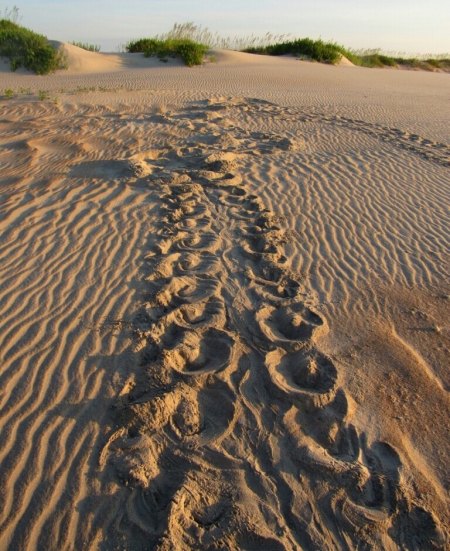Tracking Turtles
Vacationers from all over the place come to their “happy place”, shore birds fly in to nest near the dunes and along the flats, large insects relentlessly bite anything they can, and sea turtles emerge from the ocean to lay their eggs.
Growing up in central Maryland afforded me the opportunity to see a wide array of critters, but not often did we see coastal animals. Since moving to Ocracoke I’ve become what you might describe as obsessed with sea turtles. These marine reptiles breathe air, swim thousands of miles annually, nest on tropical and sub-tropical beaches worldwide, and weigh hundreds of pounds. Until mature enough to reproduce, sea turtles spend the first 20 to 30 years of their lives swimming around the Atlantic or Pacific gyre. Healthy males will never return to land, but may wash up as a result of injury or death. Females can also be seen washed up due to injury or death, but more commonly come out of the sea to nest. Sea turtles have survived for millions of years and were once worshipped and idolized by tribes of long ago. These tribes believed the world rested on the back of a sea turtle shell, and were mystified by these large creatures which labored onto the beach in the middle of the night to lay their eggs, only to disappear back into the vast ocean.
Since 2013 I’ve been a volunteer with the National Park Service on Ocracoke, which has afforded me wonderful and inspiring experiences, while also forcing me to bear witness to the harsh, brutal, conditions the wildlife here endures. Natural and introduced predators and severe weather events can wreak havoc on bird and turtle eggs, as well as chicks and hatchlings. I’ve seen how high tides wash away Piping Plover eggs and that a variety of predators eat eggs and birds. Standing water after high tides can, for lack of a better word, sometimes drown developing sea turtles inside their eggs, destroying the entire nest. Water that has accumulated over a nest can slow the development of the turtles, but seeing standing water on a nest doesn’t necessarily mean the nest will be destroyed. Ghost crabs and gulls also pose a threat to the tiny creatures, picking off newly emerged hatchlings as they scramble towards the surf. Gulls and ghost crabs will predate bird eggs, chicks, and even adult birds.
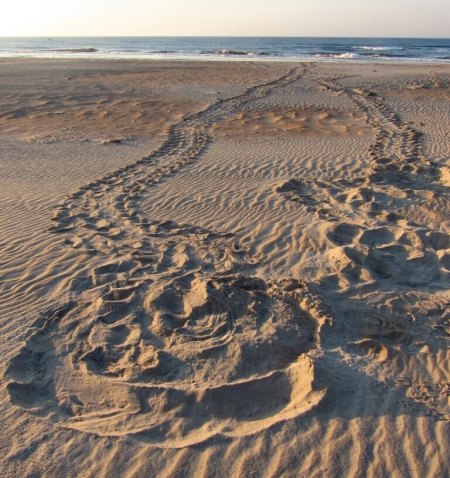
A lot of good happens, too. This summer is the second of which I’ve gone on Turtle Patrol, where I assist a biological technician (bio tech) with a variety of tasks, babysit nests that could hatch at any moment, and get the chance to watch hatchlings come out of the ground and sprint for the ocean. Once a week – I go on Sundays – before the sun comes up I meet a bio tech and we load our things into a UTV. The UTV, a Gator, is basically an off-road golf cart. The “doors” are fabric and netting, and the roof is a piece of cloth. The rear window is clear vinyl, and there’s no front windshield. We are required to wear seatbelts and a helmet that resembles a bowling ball. I feel like a 5’9” bobblehead toy when I wear the helmet, and because it covers my ears I feel like every time I speak to Sam – the bio tech – I have to shout over the sound of the Gator’s engine and through our bowling ball headgear.
Feeling the morning air can be really nice. Even on windy days, when sand and dirt and road gick are being blown around it’s still an enjoyable ride. But then there are the bugs, lots of them. I can very clearly hear when one slams into my bowling ball helmet, feel the sting when they fly into my face or chest, and I am all too aware of them when one flies into my mouth. While we drive down South Point Road I generally stay quiet. If I absolutely have to say or ask something I turn my bobblehead to the side, but typically I try to keep calm and quiet since I am more of a morning person than most.
With the sun rising from the east, colorful streaks fill the sky and brighten the horizon. The tall marsh grasses along South Point Road are illuminated with golden and orange tones, and the sea oats lining the dunes appear to be black against the background of early morning colors. Once we get passed the dunes and onto the beach, we can see the calm ocean reflecting pinks and yellows and oranges produced by the sun. Sandpipers, Willets, American Oyster-catchers, terns, and gulls move hurriedly along the shoreline searching for food. Some of them fly overhead and dive-bomb to catch a fish; Pelicans gracefully soar and arch over the waves in search for breakfast, then create quite a splash as they dive into the water at up to 65mph. Among the early morning bird activity we look for sea turtle tracks.
When searching for sea turtle tracks in a vehicle area, I tend to look a bit more carefully. Unless you know what you’re looking for, the tracks may appear like those made by a motorist who drove closer to the water than others. Sometimes, sea turtle tracks even look like someone really dug their tires in the sand, maybe in an effort to become freed from becoming sand-stuck. The first time seeing sea turtle tracks was magical. I’d seen photos and taken time to learn about the marine reptiles, but nothing really prepared me for actually seeing the swirl-swirl, swirl-swirl left behind in the sand by a female loggerhead. It’s also pretty amazing to think about the amount of time and energy it takes a several-hundred pound animal to crawl out of the water and lug herself up onto the beach. It’s hard enough for us to walk in the soft sand; imagine the challenge these heavy and flippered marine creatures (who move quite efficiently in the water) experience when they reach the soft dry sand.
Once she finds an area well suited enough for a nest, she creates a body pit in the sand and digs a nest chamber. When she’s ready to lay her eggs she goes into a trance until she’s done. Then, she covers up her nest, exits the area, and heads back into the ocean. Turtles don’t back up, so their tracks circle around and can create a loop. Not all turtles that come ashore nest, however. For various reasons, such as severe weather or a disturbance (human or animal), a turtle may come up on the beach, begin to dig a nest, but then abandon her efforts. This results in what’s called a false crawl.
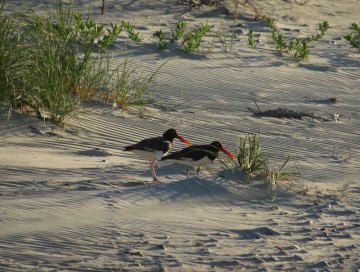
Biologists and volunteers are responsible for identifying if the tracks lead to an actual nest or if it’s a false crawl. Along Cape Hatteras National Seashore, turtle nests, as many of you know, are roped off to prevent nest destruction by foot and vehicle traffic. These roped off areas remain small until the nests are ready to hatch. Park biologists keep track of when the nests were laid to allow accurate timing for closure expansions, and they keep data indicating GPS points for the nest, they bury a GPS tracker near the nest for location purposes in the event a storm washes away the signage, take DNA samples for long-term tracking studies, and will measure the nest depth and width if a relocation is necessary. All that scientific stuff is pretty much left up the biologists, but I do get help dig in the sand and locate the eggs if there are any. While Sam enters the data, I begin placing the signs and stringing the rope to form the small closure. Once we are done we have to rake out the tracks so others who visit the area don’t think a nest was overlooked or just made. Then, we go on our way.
The biologists are responsible for more than locating and protecting turtle nests. They are all also very knowledgeable about birds, and are required to do a variety of tasks to protect the adults, eggs, and any chicks and fledglings. I don’t participate in any of the bird tracking, but being on Turtle Patrol has allowed me the opportunity to see American Oyster-catcher and Black Skimmer chicks and fledglings, as well as other water birds and shore birds.
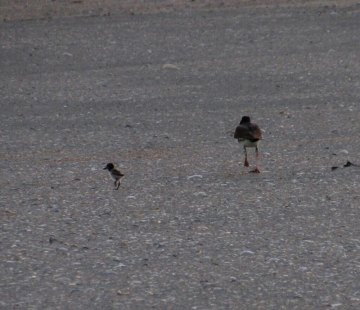
Birds nest all along the island. Some prefer the flats, which is why the northern and southern ends of Ocracoke are currently closed to pedestrian and vehicle traffic, while others prefer areas around the dunes. When out looking for turtle nests, Sam is also checking up on all the feathered residents. Some are banded, so he records their locations and that he’s seen them. He also identifies the chicks and fledglings and notates if all are accounted for or if any are missing. It’s amazing to watch the biologists work; they’re able to recognize the birds from far distances, and refer to them by their band number. The banded birds are tracked year round, and more and more birds are banded each year to track their movements. Banding allows scientists to track the birds for life, track their mating patterns, nesting site preferences, and longevity among other things.
Depending on the amount of nests, Turtle Patrol can take five or six hours or closer to eight. By the time we head back to town – no matter how long we’ve been out – its’ typically hot and steamy. Being up early can make you tired, then add in the intense sun and humidity and you have the perfect recipe for a nap… and a shower.
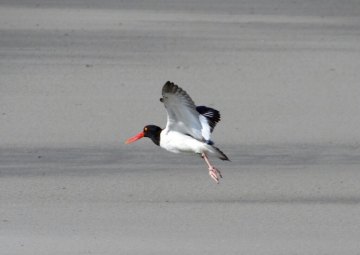
Turtle nesting activity is at its peak now, so there may be an increasing amount the small protected areas seen along the seashore. In areas that are easily accessible to pedestrians, the National Park Service may host excavation events where the public will have the opportunity to watch biologists check nests for any unhatched eggs and release any remaining hatchlings. These public excavations occur later in the summer and are announced as soon as possible. All information regarding public turtle nest excavations can be obtained by reading the National Park Service paper, In the Park. These papers are free and available at every National Park Service Visitor Center on the Seashore. You can also call the Turtle Hotline number 252-475-9629. If you see turtle tracks that appear to be fresh, call 252-216-6892.
So far this year, there are 59 turtle nests on Ocracoke. The nesting season lasts from May until mid-September. In 2015, Ocracoke had a total of 86 turtle nests.
